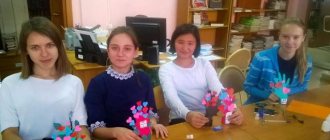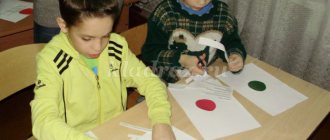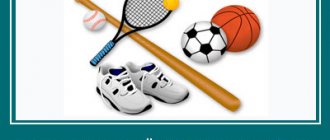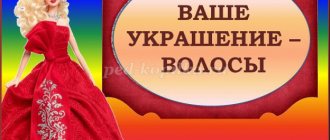Lesson No. 35. “Healthy lifestyle”, 3rd grade
Film lesson book “The world around us” 3rd grade
Lesson type:
combined
Target
— formation of a holistic picture of the world and awareness of man’s place in it based on the unity of rational-scientific knowledge and the child’s emotional and value-based understanding of his personal experience of communicating with people and nature;
Problem:
What is a healthy lifestyle?
Tasks:
introduce a healthy lifestyle.
Subject results
Learn to follow the rules of maintaining and promoting health.
Universal educational activities (UUD)
Regulatory:
look for reasons to adequately evaluate your achievements and ways to overcome difficulties.
Cognitive:
extract relevant information while reading and listening.
Communicative:
engage in educational dialogue, formulate your own thoughts.
Personal results
Formation of an attitude towards a safe, healthy lifestyle.
Basic concepts and definitions
Healthy lifestyle, bad habits
Preparing to learn new material
Let's find out what it means to lead a healthy lifestyle. Let's formulate the rules of a healthy lifestyle and learn to follow them.
Remember the rules for maintaining and promoting health that we learned in class.
Take a guess at what it means to lead a healthy lifestyle. Test yourself using the textbook.
One boy knew very well all the rules for maintaining and promoting health. I knew, but almost never followed them. Sometimes I forgot, sometimes I was lazy, sometimes I was in a hurry and said to myself: tomorrow I’ll do everything right, but today I’ll do it somehow. But the next day the same thing happened again, and the next day... Do you think this boy will be healthy?
Studying new material and understanding the information received
The rules for preserving and strengthening health only bring real benefits to those who follow them not occasionally, but constantly, who live by these rules. They say about such a person: he leads a healthy lifestyle.
Based on the textbook text and your own knowledge, reveal each rule of a healthy lifestyle. Discuss them in class. Think about what needs to change in your behavior in accordance with these rules.
1.Keep it clean!
Keep your body, clothes and home clean. You need to wash your face and hands, brush your teeth, take a shower, wash with soap and a washcloth, clean your shoes and clothes, ventilate the room, regularly clean your apartment, keep your yard clean, never throw garbage on the streets past the trash can... A healthy lifestyle starts with cleanliness!
2.Eat right! Healthy eating is one of the foundations of a healthy lifestyle. What kind of food can be considered healthy? Varied, rich in vegetables and fruits, regular, without haste? Or monotonous, rich in sweets, from time to time, in a hurry? Perhaps the answer is obvious.
3. Combine work and rest!
Studying at school and doing homework is serious work. It happens that third graders are no less busy than adults. In order to maintain health, it is imperative to alternate work with rest. A modern schoolchild usually has many opportunities for recreation and entertainment, including TV, videos, and computer games. But some kids turn on the TV in the morning, even before school, and sit at the computer for hours after school. This is harmful, especially to the nervous system and vision. TV, videos, computer games are good in moderation. Don't get too carried away with them. Include walks, outdoor games, and reading books in your daily routine.
4.Move more!
A sedentary lifestyle is harmful to your health, so try to move more. Do exercises in the morning. Play outdoor games more often, especially outdoors. Do physical labor and physical education. If possible, visit the pool.
Sports games, skiing and skating, swimming are a reliable path to health.
5.Don’t start bad habits!
The most harmful habits are smoking, drinking alcohol and drugs.
Smoking is very harmful to the lungs, and to the whole body. A child who starts smoking grows worse, gets tired faster during any work, copes poorly with school, and gets sick more often. All this happens because tobacco smoke contains a dangerous poison - nicotine and many other harmful substances. A non-smoker's lungs are pink, but someone who has been smoking for a long time turns gray from harmful substances. Scientists have calculated that for every cigarette smoked, a person’s life is shortened by 15 minutes.
Alcohol (alcohol), which is contained in alcoholic drinks, when consumed in moderation, causes diseases of the stomach and other organs and disrupts the functioning of the entire body. Alcohol is especially dangerous for children. Even a few sips of alcohol can cause severe poisoning in a child.
Drugs are special substances that destroy the human body. Having tried a drug, a person gets used to it and can no longer do without it. He develops a serious illness - drug addiction, which is very difficult to cure. The drug disrupts the functioning of the brain and the entire body and ultimately kills the person. Drug distribution is a dangerous crime that is severely punished.
To stay healthy, never start smoking, don’t try alcohol, don’t touch drugs.
Conclusion
Leading a healthy lifestyle means constantly following the rules of maintaining and strengthening health: keeping clean, eating right, combining work and rest, moving a lot, not having bad habits.
Independent application of knowledge
check yourself
1.What does it mean to lead a healthy lifestyle?
2.List the main rules of a healthy lifestyle. 3. What bad habits destroy your health?
Homework assignments
1. Write in the dictionary: healthy lifestyle.
2.Ask the adults in your family to help you lead a healthy lifestyle. Try to follow the rules of staying healthy together.
Maintaining
health
Basics
a
healthy lifestyle 15 facts about human health and arguments in favor of sports
10
FACTS ABOUT THE BENEFITS OF SPORTS
The influence of mobile phones on the brain and human health.
Damage
from a cell phone !!!
DAILY MENU | PROPER NUTRITION
THREE RULES for CLEANNESS in the house
Information sources
:
A. A. Pleshakov textbook, workbook The world around us, grade 3 Moscow
"Enlightenment" 2014
YouTube
website : https://www.youtube.com/
Hosting of presentations
around the world
- https://ppt4web.ru/nachalnaja-shkola/prezentacija-k-uroku-okruzhajushhego-mira-vo-klasse-chto-takoe-ehkonomika.html
Work program for grades 1-2 on extracurricular activities “It’s great to be healthy”
Municipal educational budgetary institution
Secondary school No. 21
WORKING PROGRAMM
Extracurricular activities
for students in grades 1-2
Title: "It's Great to Be Healthy"
Direction: sports and recreation
FULL NAME. teacher - program developer: Grigorieva Irina Alekseevna
2018-2019 academic year
“If a person takes care of his own health, it is difficult to find a doctor,
who would know better what is good for his health than he himself.”
Socrates
Explanatory note
The work program for the sports and recreational area “It’s great to be healthy” is compiled in accordance with the Federal State Educational Standard for Primary Education.
Human health is a topic quite relevant for all times and peoples, and in the 21st century it becomes paramount. The state of health of Russian schoolchildren is of serious concern to experts. A clear indicator of ill-being is the deterioration in the health of schoolchildren compared to their peers ten or twenty years ago. Moreover, the most significant increase in the incidence of the disease occurs in age periods coinciding with the receipt of general secondary education.
In modern conditions, the problem of maintaining children's health is extremely important due to the sharp decline in the percentage of healthy children. Many explanations for the current situation can be offered. This includes an unfavorable environmental situation, a decline in living standards, neuropsychic stress, etc. A very significant factor in “school ill health” is the inability of the children themselves to be healthy, their ignorance of the elementary laws of a healthy life, the basic skills of maintaining health. The lack of personal health priorities contributes to the significant spread of various forms of destructive behavior among children, including smoking, alcoholism and drug addiction.
In recent years, our school has accumulated experience in implementing health-preserving support and regularly conducts health monitoring. Based on monitoring, it can be stated that the incidence of illness among students, especially in primary school, is increasing every year. The most common cases of vision impairment, gastrointestinal diseases, musculoskeletal disorders, and obesity.
This served as the pedagogical basis for drawing up and introducing into extracurricular activities a work program in the sports and recreational area “It’s healthy to be healthy,” which includes knowledge, attitudes, personal guidelines and norms of behavior that ensure the preservation and strengthening of physical and mental health. The main idea of the program is to motivate students to lead a healthy lifestyle, to develop the need to maintain physical and mental health as a necessary condition for a person’s social well-being and success.
The program is aimed at achieving the following GOALS
:
- development of self-esteem and self-control skills in relation to one’s own health;
- training in ways and techniques to preserve and strengthen one’s own health;
- formation of communication skills.
The goals are specified by the following TASKS:
- to form ideas about: factors influencing health: proper (healthy) nutrition and its regimen; healthy products; rational organization of daily routine, study and rest; motor activity; the causes of addiction to tobacco, alcohol and other psychoactive substances, their harmful effects on health; the main components of a culture of health and a healthy lifestyle; the influence of emotional state on health and general well-being.
- To develop the need to fearlessly consult a doctor regarding health issues, including those related to growth and development.
- To develop in students the necessary knowledge, skills and abilities for a healthy lifestyle; motivational sphere of hygienic behavior, safe life, physical education.
- Teach how to use the acquired knowledge in everyday life.
- To teach conscious choice of behavior patterns that allow you to maintain and improve health.
- Instill the need to observe the rules of personal hygiene and the willingness to independently maintain one’s health.
General characteristics of the program
Program of extracurricular activities in sports -
the health direction “It’s great to be healthy” is intended for students in grades 1-2. All extracurricular activities are held after all lessons of the main schedule, the duration complies with the recommendations of SanPiN..
Timing and stages of program implementation:
Stage I - 1st grade (1 time per week, 4 times per month)
Stage II - 2nd grade (1 time per week, 4 times per month)
The study of program material begins in the 1st grade at a level accessible to younger schoolchildren, mainly in the form of educational games and in the process of practical activities, convincing students to do morning exercises every day, observe the student’s daily routine and rest, basic hygiene standards for maintaining health, performing physical exercises, exercises for relaxation, concentration, development of imagination. And it continues in 2nd grade - increasing the priority of a healthy lifestyle, motivation for physical activity, and a healthy lifestyle.
Place of the program in the curriculum
The program lasts 2 years. In grades 1-2, 33 hours per year.
The program is designed for children 7-10 years old. The number of students in the group is 10-15 people.
Planned results
Personal results.
- Determine and express, under the guidance of a teacher, the simplest and most common rules of conduct in cooperation for all people (ethical standards).
- Learn to live a safe and healthy lifestyle.
- In situations of communication and cooperation proposed by the teacher, based on simple rules of behavior common to everyone, make a choice, with the support of other group members and the teacher, what to do.
- Master the skills to organize health-saving activities (daily routine, morning exercises, health activities, healthy habits, outdoor games, etc.)
- Learn to formulate simple rules for a healthy lifestyle.
- Learn how to take good care of yourself and your health
others, disease prevention, first aid
Meta-subject results
program is the formation of the following universal learning activities (UAL):
- Regulatory UUD:
- Determine and formulate the purpose of activities during extracurricular activities with the help of a teacher.
- Speak out the sequence of actions.
- Learn to express your assumption (version) based on working with an illustration, learn to work according to the plan proposed by the teacher.
- Learn, together with the teacher and other students, to give an emotional assessment of activities about the importance of sports and recreational activities for improving health, for successful studies and socialization in society.
2. Cognitive UUD:
- Make a preliminary selection of sources of information: navigate through additional sources necessary to solve a given topic (on the double page, in the table of contents, in the dictionary).
- Gain new knowledge: find answers to questions using additional paper and digital media, your life experience and information received in the classroom.
- Process the information received: draw conclusions as a result of joint work of the whole class.
- Convert information from one form to another: compose stories, memos based on the simplest models (subject models, drawings, schematic drawings, diagrams);
- Find and formulate a solution to a problem situation using simple models (object models, drawings, schematic drawings).
3. Communicative UUD:
- Listen and understand the speech of others.
The means of forming these actions is the technology of problem dialogue (inducing and leading dialogue).
- Jointly agree on the rules of communication and behavior at school and extracurricular activities, and follow them.
- Learn to perform different roles in a group (leader, performer, critic).
- Adequately assess your own health and the health of others.
- If necessary, defend your point of view, giving reasons for it.
The following technologies were used to form the UUD:
— gaming technology;
— technology of problematic dialogue;
— technology for assessing educational achievements;
— technology of person-centered learning.
PROGRAM CONTENT
Health secrets
If you want to be healthy… . My health is fine - thanks to exercise. You and the world of sports. What helps you be strong and agile. Beautiful posture. Computer - good or bad. Bad habits - what are they...? Secrets of the heroic health of the Cossacks living on the Don.
Proper nutrition.
The most useful products. Honey is a wonderful gift of nature. Varieties of honey from the Don region. Bread is the head of everything. Secrets of the bakers of the Don Cossacks. Vitamins are the source of health. Vegetables are a pantry of health. What is porridge made from and how to make porridge tasty. Fruits are a delicacy and medicine. Dairy country. Secrets of proper nutrition from Don cuisine. Who chews long lives long? Every man to his own taste. "My Grandma's Recipes" Water is the source of life. Where do vitamins live? “Miracles” in my mother’s kitchen...Proverbs and sayings about nutrition.
Lifestyle.
Cultural and hygienic skills.
Where do dirt come from? Schoolboy mode. Keep your body clean. Our friends are water and soap. Visiting Moidodyr. Neatness and neatness in clothing. So that your teeth don't hurt. Rules for dental care. Gymnastics for the eyes. Skin hygiene. So that the ears can hear. The sun, air and water are our faithful friends.” How to breathe properly outside?
Sleep and its benefits. Dress for the season. Ways to protect against diseases. Secrets of the longevity of the Don Cossacks. Health is great!
Medical services.
Call a doctor at home. Doctor's work. Visit doctor. The famous A.P. Chekhov is a writer and doctor. Service 03. The benefits and harms of medications. Your home first aid kit. Emergency assistance, rescue service. Specialties of doctors.
Fire safety rules.
Fire is friend and foe. Matches are not a toy for children.
Rules of behavior in everyday life.
There is danger at home. Safety when interacting with pets.
Rules of behavior in nature.
If it's sunny and hot. If it is raining and thunderstorm outside. Water safety rules. Rules for safe behavior on water bodies of the Taganrog Bay. Poisonous plants. Harmful mushrooms and berries of the Don region. Be careful: ticks! Primary first aid skills for yourself and a friend. Quiz "My Safety". Game-trip to the kingdom “Be Healthy”.
Forms of work:
- Outdoor games
- Travel game
- Practical lessons
- Educational activities
- Quizzes
- Project activities
- Research activities
Thematic planning
| № p/p | Number of hours | Chapter. Topic of the lesson. | Activities. |
| Health secrets | |||
| 1 | 1 | If you want to be healthy... | Conversation. Coloring coloring pages depicting a healthy lifestyle. |
| 2 | 1 | My health is fine - thanks to exercise. | Watching and discussing the video |
| 3 | 1 | “Morning exercises in the life of my family.” | Project activities |
| 4 | 1 | You and the world of sports. | Watch and discuss the video. Outdoor games |
| 5 | 1 | What helps you be strong and agile. | Presentation: Coloring coloring pages depicting a healthy lifestyle |
| 6 | 1 | Beautiful posture. | Watching and discussing the video |
| 7 | 1 | Computer - good or bad. | Watching and discussing the video |
| 8 | 1 | Bad habits - what are they...? | Coloring coloring pages depicting a healthy lifestyle. Drawing up a reminder about bad habits. |
| 9 | 1 | Secrets of the heroic health of the Cossacks living on the Don. | Conversation. Presentation |
| Proper nutrition. | |||
| 10 | 1 | The most useful products. | Conversation. Presentation. Compiling a list of useful products. |
| 11 | 1 | Honey is a wonderful gift of nature. Varieties of honey from the Don region. | Watch and discuss the video. |
| 12 | 1 | Bread is the head of everything. Secrets of the bakers of the Don Cossacks. | Watch and discuss the video. |
| 13 | 1 | Vitamins are the source of health. | Presentation Watch and discuss the video. |
| 14 | 1 | Vegetables are a pantry of health. | Modeling vegetables from plasticine. Watch and discuss the video. |
| 15 | 1 | What is porridge made from and how to make porridge tasty. | Reading and discussion of the Russian folk tale “Porridge from an Axe” |
| 16 | 1 | Fruits are a delicacy and medicine. | Watch and discuss the video. Modeling fruits from plasticine. |
| 17 | 1 | Dairy country. | Watch and discuss the video. |
| 18 | 1 | Secrets of proper nutrition from Don cuisine. | Presentation. |
| 19 | 1 | Who chews long lives long? | Conversation. Coloring pages on the topic of proper nutrition. |
| 20 | 1 | Every man to his own taste. "My Grandma's Recipes" | Project activities |
| 21 | 1 | Water is the source of life. | Conversation about the benefits of water. Watch and discuss the video. |
| 22 | 1 | Where do vitamins live? | Drawing competition. |
| 23 | 1 | “Miracles” in my mother’s kitchen... | Research activities |
| 24 | 1 | Proverbs and sayings about nutrition. | Conversation. Reading proverbs and sayings about nutrition. |
| Lifestyle. Cultural and hygienic skills. | |||
| 25 | 1 | Where do dirt come from? | Watch and discuss the video. |
| 26 | 1 | Schoolboy mode. | Story. Outdoor game “Prohibited movement” |
| 27 | 1 | Keep your body clean. | Watch and discuss the video. |
| 28 | 1 | Our friends are water and soap. Visiting Moidodyr. | Watch an excerpt from the cartoon "Moidodyr". Outdoor game “Repeat after me” |
| 29 | 1 | Healthy lifestyle in my family. | Research activities. |
| 30 | 1 | So that your teeth don't hurt. Dental care rules | Watch and discuss the video. Practical lesson |
| 31 | 1 | Gymnastics for the eyes. | Presentation. Preventive exercises. Outdoor game "Marksman" |
| 32 | 1 | Skin hygiene. | Practical lesson. |
| 32 | 1 | So that the ears can hear. | Outdoor game “Guess whose voice” |
| 34 | 1 | The sun, air and water are our faithful friends" | Conversation. Outdoor game “Cones, acorns, nuts” |
| 35 | 1 | How to breathe properly outside? | Conversation. Watch the video. Practical lesson |
| 36 | 1 | Sleep and its benefits. | Presentation Outdoor game “The sea is agitated” |
| 37 38 | 2 | Dress for the season. | Conversation. Presentation. |
| 39 40 | 2 | Ways to protect against diseases. | Conversation. Presentation |
| 41 | 1 | Secrets of the longevity of the Don Cossacks. | Conversation. Project activities. |
| 42 | 1 | Health is great! | Drawing competition. |
| Medical services. | |||
| 43 | 1 | Call a doctor at home. Doctor's work. | Presentation. Visit to school medical center office |
| 44 | 1 | Visit doctor. The famous A.P. Chekhov is a writer and doctor. | Conversation. Presentation. Game "Hospital" |
| 45 | 1 | Service 03 | Presentation. Practical lesson “How to properly call an ambulance, my step-by-step actions...” |
| 46 47 | 2 | The benefits and harms of drugs. Your home first aid kit. | Presentation. Watch the video and discuss what you saw. |
| 48 | 1 | Emergency assistance, rescue service. | Conversation. Excursion to the school paramedic's office. |
| 49 50 | 2 | Specialties of doctors. | Conversation Presentation |
| Fire safety rules. | |||
| 51 52 | 2 | Fire is friend and foe. | Conversation. Watch a video about the benefits and dangers of fire. |
| 53 | 1 | Matches are not a toy for children. | Presentation. Watching a cartoon. |
| Rules of behavior in everyday life. | |||
| 54 55 | 2 | There is danger at home. | Conversation Watching the cartoon “The ABCs of Safety” |
| 56 | 1 | Safety when interacting with pets. | Conversation. Video “Tips from Aunt Owl” |
| Rules of behavior in nature. | |||
| 57 | 1 | If it's sunny and hot. | Conversation. Outdoor games |
| 58 | 1 | If it is raining and thunderstorm outside. | Conversation. Learn to make reasonable decisions in the current situation. Practical lesson. |
| 59 60 | 2 | Water safety rules. Rules for safe behavior on water bodies of the Taganrog Bay. | Watching the cartoon “The ABCs of Safety.” Formation of safe behavior skills on water bodies. |
| 61 62 | 2 | Poisonous plants. Harmful mushrooms and berries of the Don region. | Presentation. Modeling of mushrooms and berries from plasticine. |
| 63 | 1 | Primary first aid skills for yourself and a friend. | Conversation. Presentation. Instilling primary first aid skills. |
| 64 65 | 2 | Quiz "My Safety". | Games, riddles, competitions. |
| 66 | 1 | Game-trip to the kingdom “Be Healthy”. | Travel game. |
Material and technical support
Digital educational resources
- “The ABC of Health” - videos - Project “Video lessons on the Internet”, 2008–2020, LLC “Multilesson”
- DVD “Lessons from Aunt Owl” - TO “Masks”, Moscow, 2009.
- DVD “The ABCs of Road Safety” - TO “Masks”, Moscow, 2013
Literature
1. Antropova, M.V., Kuznetsova, L.M. Schoolchild's daily routine. M.: ed. . 2002.
2. Kovalko, V.I. Health-saving technologies in elementary school [Text]: grades 1-4 / V.I. Kovalko. – M.: Vako, 2004.
3. Zaitsev G.K. Lessons from Aibolit. - St. Petersburg, -1997., Lessons from Moidodyr. - St. Petersburg, -1996., Your first health lessons - St. Petersburg, 1995.
4. Patrikeev, A.Yu. Outdoor games. 1-4 grades. M.: Vako, 2007. - 176 p. — / Mosaic of children's recreation.
5. Sinyagina, N.Yu. How to preserve and strengthen the health of children: psychological attitudes and exercises [Text] / N.Yu. Sinyagina, I.V. Kuznetsova. – M.: Vlados, 2003.
6. Mayurov A.N. Lessons on health culture. In a healthy body healthy mind. Uch. manual for students and teachers. M.: Pedagogical Society of Russia, 2004
7. Electronic textbook for grade 1 “The world around us” part 2 G.G. Ivchenkova, I.V. Potapov - AST Publishing House, Moscow 2015.






